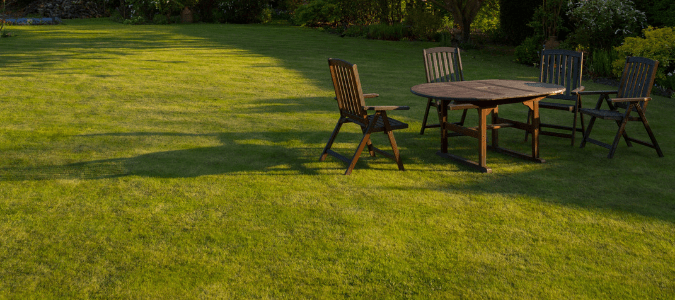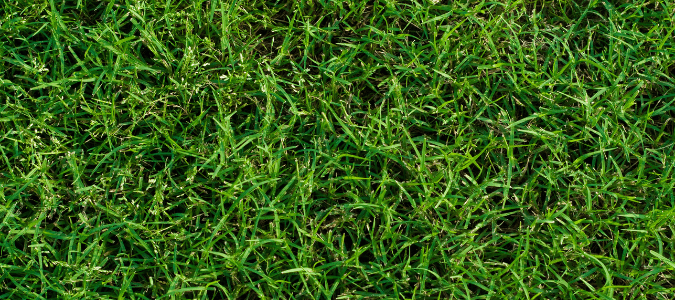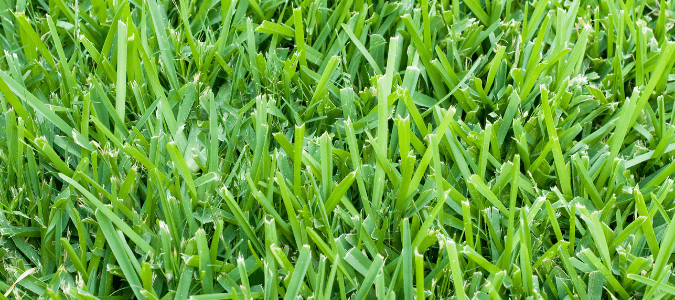Lush lawns are a homeowner’s dream, a beautiful green canvas that not only frames the home but also provides a soft setting for recreational activities. As we all know, such lawns don’t just happen. They take regular maintenance and care—even throughout the winter months.
The amount of upkeep a lawn requires relies in large part on the type of grass used. Two common varieties used in lawns across the nations are Bermuda and St. Augustine. Each has its own set of needs in order to keep it looking its best in a variety of weather conditions. A landscaping professional can answer specific questions about how either variety would be likely to perform in your area.
Let’s look at the qualities of each type of grass, how it works as a lawn grass and any special needs that each type might require.
Bermuda
Bermuda grass, pictured above, is known for being a tough variety that can withstand extreme heat and drought conditions. It can take just about anything you can throw at it, whether your family uses the lawn for running rampant or your pets rule the yard. In fact, it withstands traffic so well that it is used on many golf courses on the greens.
To determine if this is the kind of grass you have in your yard, look for a coarse texture as well as an extensive root system above the ground, with those roots called stolons. Also look for small hairs that look a bit like a bird’s foot near the intersection of the leaf blade and sheath.
Bermuda is the preferred lawn grass in much of the southern half of the United States. Because of its love of heat, Bermuda grass does not do as well in cooler climates. This type of grass is native in many tropical and subtropical areas of the world.
Bermuda grass can handle a lot of traffic in part because it grows so quickly. The grass’ roots go deep, usually around 6 inches down but some can extend up to 6 feet into the earth! That type of root system helps Bermuda grass stay alive during very dry conditions.
This type of grass can grow from seed into a gorgeous and full lawn, and is a perennial grass, meaning it comes back every year, growing from spring through late summer. In areas that don’t see a frost, Bermuda grass can stay green all year.
St. Augustine Grass
This variety, also known as Buffalo grass, also thrives in hot and relatively dry conditions. One distinction between this type and Bermuda grass is that St. Augustine also tolerates salty conditions. In fact, it will thrive in many harsh, southern climates as long as the soil is well-drained.
St. Augustine, pictured above, is a beautiful, blue-green carpet grass that is very common in the southern United States. It is usually grown from sod or plugs, the most common way for installation. The grass keeps its green color longer than most warm-weather varieties. If you want to know if your lawn is St. Augustine, look for large, flat stems and short, broad leaves.
How Care Differs for Bermuda Grass Versus St. Augustine
Both varieties do well in warm climates and perform better than most in drought conditions. However, the care needs for Bermuda grass and St. Augustine can be very different, and these details are important to note before selecting a variety for your lawn. If you live in a home that already has one of these installed in the yard, this comparison will give you a better idea of how to care for what you have, or maybe an incentive to replace it! In either case, contacting a lawn professional is always a great idea for a comprehensive lawn care plan.
How Much Sun?
Sun is a friend to both Bermuda and St. Augustine, but to a different extent. If you have or are looking at getting Bermuda grass, consider how much tree cover you have. Bermuda needs pretty much full sunlight to thrive. Anything less inhibits the photosynthesis that is required for maximum growth.
St. Augustine, in contrast, needs at least five hours of sunlight to do its best. More is fine, too, but St. Augustine reacts to lower light better than Bermuda grass will.
Watering Needs
St. Augustine requires a stricter watering schedule than Bermuda grass does. With Bermuda, you will probably need to water up to three times a week in the heat of summer but in winter, because it goes dormant, no watering is needed.
However, with St. Augustine grass, you will need to water four times or more every week during summer, up to one and a half inches a week. That is about twice as much water as Bermuda grass needs!
The More You Mow
You might be surprised to know that the type of grass in your lawn can dictate how often it needs mowing, either by you or someone else! As we said earlier, Bermuda grass grows quickly and spreads out a good bit. It is generally healthiest when it is kept about a half-inch to one and a half inches tall.
St. Augustine is usually kept about two to four inches tall and doesn’t have the same growth pattern that Bermuda does. In this category, St. Augustine beats Bermuda. Because Bermuda spreads so rapidly, it can grow over your flower beds or sidewalks before you know it, requiring frequent edging, at minimum.
Watch for These Diseases
Like any living plant, diseases can pop up either due to climate conditions or pests—or both. Bermuda grass and St. Augustine are no different.
With Bermuda, the biggest foes are fungal issues. Your Bermuda lawn might see things like brown patch, dollar spot, leaf spot, pythium, fair rings or springs dead spot. Sometimes, you won’t even be able to see the fungus. If you do see a brown patch or spot that doesn’t look right, wait a couple of days. If the patch grows, it’s a good time to contact a lawn care professional to get the correct treatment and stop the spread of the disease.
Water can make such fungal growth worse, so if the weather is moderate and humid, hold off on watering until the air dries out. If things are hot and humid, water in the morning so extra moisture can burn off during the day.
St. Augustine can fall victim to fungal diseases as well. Yellowing or brown patches could mean you are dealing with brown patch, gray leaf spot disease, fairy rings or Nigrospora Stolon Rot. To stop the spread of such fungi, you will need to talk to a lawn pro and get a commercial fungicide lawn treatment for the best results.
Creepy Crawlies
Naturally, because we are talking about living, outdoor vegetation, pests are going to be an issue from time to time. Both kinds of turf attract grub worms, which are the larval phase of scarab beetles. Armyworms and sod worms also like to make their home in both Bermuda grass and St. Augustine.
One common St. Augustine grass problem is chinch bugs. They are very tiny black bugs that absolutely love to dine on this grass! In fact, it can be hard to determine if damage you are seeing in your St. Augustine lawn is from chinch bugs or drought issues. A lawn care professional will be able to help you easily determine what is causing your lawn to look worse for wear, and give you a proper treatment plan that fits your care needs.
Invasive Weeds
Of course, grass isn’t the only thing that grows in your lawn. Various weeds pop up throughout the year, in both varieties, not only making your yard look bad but also possibly interfering with the healthy growth of your turf.
Within your Bermuda grass, you might find weeds such as dandelion, chickweed, doveweed, white clover, purslane or spurge. You might also find crabgrass, dallisgrass, yellow nutgrass and annual bluegrass. Even though all of this last group has “grass” in the name, they are still considered invasive.
St. Augustine is more weed-resistant than Bermuda grass, though you can still find things such as dandelion, crabgrass or dollar weed in your turf if you don’t water or fertilize regularly. Again, calling in an expert can help you determine the best year-round schedule for caring for your St. Augustine grass.
Hopefully, this clears up some confusion about common lawn grasses as well as some benefits and downsides to both Bermuda grass and St. Augustine. If your yard is already home to one or the other of these top varieties, knowing the best lawn care schedule for your grass is the best way to keep it green. And of course, if you are looking at long-term maintenance that best suits your lifestyle, you also might consider revamping your lawn and installing a variety that works for you. In either case, talk to a professional who is well-versed in both St. Augustine and Bermuda grass care calendars. They can create and implement a year-round lawn care schedule to help keep your grass healthy.
ABC Can Keep Your Lawn Green
There’s a lot involved in keeping a lawn green. And, if you don’t know what type of grass you have, maintaining a lush lawn can feel nearly impossible. Instead of playing the guessing game, contact ABC Home & Commerical Services. Our lawn care team is highly knowledgeable and can create a lawn care schedule that works for your lawn. We offer a year-round program that ensures your lawn has everything it needs to thrive. Additionally, we offer sprinkler repair, so your lawn will always have the water it needs.





Comments
It would’ve been nice if you showed pictures of side by side comparison of both grass
absolutely, I would like to see clear pictures of the grain of the grasses so I can figure out which grass is in the lawns I mow.